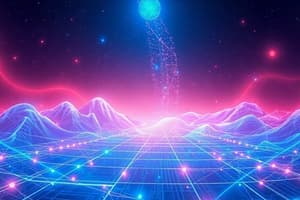Podcast
Questions and Answers
What is a computer network?
What is a computer network?
A computer network is like a graph consisting of end-systems or hosts connected to one another via communication links and packet switches.
What is the internet?
What is the internet?
The internet is a computer network that interconnects billions of computing devices throughout the world.
Who invented the World Wide Web?
Who invented the World Wide Web?
- Bob Khan
- Leonard Kleinrock
- Ray Tomlinson
- Tim Berners Lee (correct)
What is an ISP?
What is an ISP?
What does PoP stand for?
What does PoP stand for?
Match the following terms with their definitions:
Match the following terms with their definitions:
What is the role of protocols in internet communication?
What is the role of protocols in internet communication?
What types of networks are classified by size?
What types of networks are classified by size?
Access networks can be based on ______: size, topology or physical media.
Access networks can be based on ______: size, topology or physical media.
Flashcards are hidden until you start studying
Study Notes
Introduction to Computer Networks
- A computer network comprises end-systems or hosts connected through communication links and packet switches.
- End-systems generate or receive data in packets, collections of bits.
- The sequence of packet switches and communication links is termed as a route or path.
- Administration of a computer network is usually handled by a single entity.
Internet Overview
- The Internet is a vast network interconnecting billions of computing devices worldwide.
- It provides services for distributed applications, which run across different hosts.
- Key historical developments include DARPA, ARPANET, packet switching, TCP/IP, and DNS.
Notable Inventions and Inventors
- World Wide Web: Tim Berners-Lee, MIT, 1989-90.
- Email: Ray Tomlinson, BBN, 1972.
- DNS: Paul Mockapetris, USC, 1982.
- RFC: Stephen Crocker, UCLA, 1969.
- Packet Switching: Leonard Kleinrock, UCLA, 1961.
- TCP/IP: Bob Kahn and Vincent Cerf, DARPA/SRI, 1972-73.
- Ethernet: Bob Metcalfe, Xerox PARC, 1973.
Internet Ownership and Control
- Internet access is provided by Internet Service Providers (ISPs), which charge subscription fees.
- End-systems connect to ISPs at points-of-presence (PoPs), with thousands of PoPs indicating ISP reach.
- PoPs include routers, link layer switches, and communication links.
ISP Hierarchy and Revenue Generation
- End users pay access ISPs, which then pay regional ISPs, leading to Tier 1 ISPs.
- Tier 1 ISPs can have bilateral agreements to share bandwidth and resources.
- Peering or multi-homing ISPs may share revenue based on resource utilization.
Distributed Applications and Services
- Applications operate independently on hosts, exchanging messages via internet socket interfaces.
- Protocols determine message format and exchange order and govern actions taken during transmission or reception.
- Services like reliability and guaranteed rates are provided by hardware or software tied to devices.
Network Edge
- The network edge encompasses computer networks that connect to the internet, categorized as access networks.
- End-systems can be classified into clients and servers.
- Gateways are routers connecting access networks to ISPs.
- Access networks can be classified based on size (local area, home, wide area), topology (tree, star, ring, bus, point-to-point), and physical media (wired or wireless).
Studying That Suits You
Use AI to generate personalized quizzes and flashcards to suit your learning preferences.




